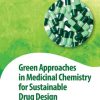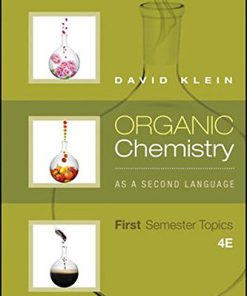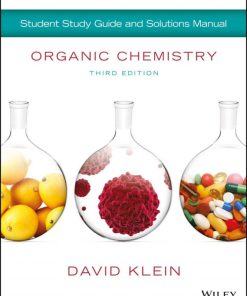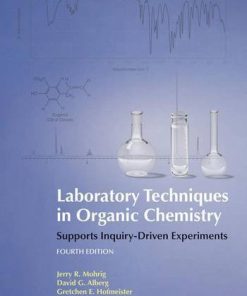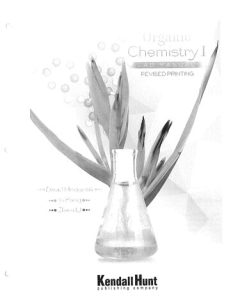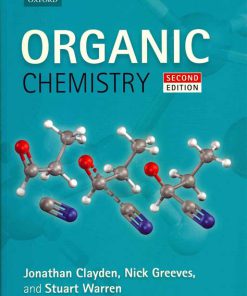Organic Chemistry 3rd Edition by David Klein ISBN 9781119338352 1119338352
$50.00 Original price was: $50.00.$25.00Current price is: $25.00.
Organic Chemistry 3rd Edition by David Klein – Ebook PDF Instant Download/Delivery: 9781119338352 ,1119338352
Full download Organic Chemistry 3rd Edition after payment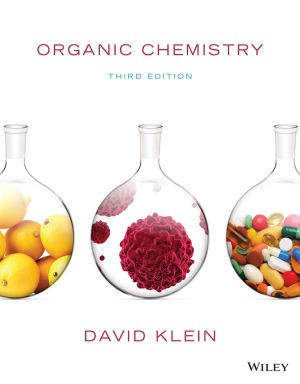
Product details:
ISBN 10: 1119338352
ISBN 13: 9781119338352
Author: David Klein
In Organic Chemistry, 3rd Edition, Dr. David Klein builds on the phenomenal success of the first two editions, which presented his unique skills-based approach to learning organic chemistry. Dr. Klein’s skills-based approach includes all of the concepts typically covered in an organic chemistry textbook, and places special emphasis on skills development to support these concepts. This emphasis on skills development in unique SkillBuilder examples provides extensive opportunities for two-semester Organic Chemistry students to develop proficiency in the key skills necessary to succeed in organic chemistry.
Organic Chemistry 3rd EditionTable of contents:
1 A Review of General Chemistry: Electrons, Bonds, and Molecular Properties
1.1 Introduction to Organic Chemistry
1.2 The Structural Theory of Matter
1.3 Electrons, Bonds, and Lewis Structures
1.4 Identifying Formal Charges
1.5 Induction and Polar Covalent Bonds
PRACTICALLY SPEAKING: Electrostatic Potential Maps
1.6 Atomic Orbitals
1.7 Valence Bond Theory
1.8 Molecular Orbital Theory
1.9 Hybridized Atomic Orbitals
1.10 Predicting Molecular Geometry: VSEPR Theory
1.11 Dipole Moments and Molecular Polarity
1.12 Intermolecular Forces and Physical Properties
PRACTICALLY SPEAKING: Biomimicry and Gecko Feet
MEDICALLY SPEAKING: Drug-Receptor Interactions
1.13 Solubility
MEDICALLY SPEAKING: Propofol: The Importance of Drug Solubility
Review of Concepts & Vocabulary
SkillBuilder Review
Practice Problems
Integrated Problems
Challenge Problems
2 Molecular Representations
2.1 Molecular Representations
2.2 Bond-Line Structures
2.3 Identifying Functional Groups
MEDICALLY SPEAKING: Marine Natural Products
2.4 Carbon Atoms with Formal Charges
2.5 Identifying Lone Pairs
2.6 Three-Dimensional Bond-Line Structures
MEDICALLY SPEAKING: Identifying the Pharmacophore
2.7 Introduction to Resonance
2.8 Curved Arrows
2.9 Formal Charges in Resonance Structures
2.10 Drawing Resonance Structures via Pattern Recognition
2.11 Assessing the Relative Importance of Resonance Structures
2.12 The Resonance Hybrid
2.13 Delocalized and Localized Lone Pairs
Review of Concepts & Vocabulary
SkillBuilder Review Properties
Practice Problems
Integrated Problems
Challenge Problems
3 Acids and Bases
3.1 Introduction to Brønsted-Lowry Acids and Bases
3.2 Flow of Electron Density: Curved-Arrow Notation
MEDICALLY SPEAKING: Antacids and Heartburn
3.3 Brønsted-Lowry Acidity: A Quantitative Perspective
MEDICALLY SPEAKING: Drug Distribution and pK[sub(a)]
3.4 Brønsted-Lowry Acidity: Qualitative Perspective
3.5 Position of Equilibrium and Choice of Reagents
3.6 Leveling Effect
3.7 Solvating Effects
3.8 Counterions
PRACTICALLY SPEAKING: Baking Soda versus Baking Powder
3.9 Lewis Acids and Bases
Review of Concepts & Vocabulary
SkillBuilder Review
Practice Problems
Integrated Problems
Challenge Problems
4 Alkanes and Cycloalkanes
4.1 Introduction to Alkanes
4.2 Nomenclature of Alkanes
PRACTICALLY SPEAKING: Pheromones: Chemical Messengers
MEDICALLY SPEAKING: Naming Drugs
4.3 Constitutional Isomers of Alkanes
4.4 Relative Stability of Isomeric Alkanes
4.5 Sources and Uses of Alkanes
PRACTICALLY SPEAKING: An Introduction to Polymers
4.6 Drawing Newman Projections
4.7 Conformational Analysis of Ethane and Propane
4.8 Conformational Analysis of Butane
MEDICALLY SPEAKING: Drugs and Their Conformations
4.9 Cycloalkanes
MEDICALLY SPEAKING: Cyclopropane as an Inhalation Anesthetic
4.10 Conformations of Cyclohexane
4.11 Drawing Chair Conformations
4.12 Monosubstituted Cyclohexane
4.13 Disubstituted Cyclohexane
4.14 cis-trans Stereoisomerism
4.15 Polycyclic Systems
Review of Concepts & Vocabulary
SkillBuilder Review
Practice Problems
Integrated Problems
Challenge Problems
5 Stereoisomerism
5.1 Overview of Isomerism
5.2 Introduction to Stereoisomerism
PRACTICALLY SPEAKING: The Sense of Smell
5.3 Designating Configuration Using the Cahn-Ingold-Prelog System
MEDICALLY SPEAKING: Chiral Drugs
5.4 Optical Activity
5.5 Stereoisomeric Relationships: Enantiomers and Diastereomers
5.6 Symmetry and Chirality
5.7 Fischer Projections
5.8 Conformationally Mobile Systems
5.9 Chiral Compounds That Lack a Chiral Center
5.10 Resolution of Enantiomers
5.11 E and Z Designations for Diastereomeric Alkenes
MEDICALLY SPEAKING: Phototherapy Treatment for Neonatal Jaundice
Review of Concepts & Vocabulary
SkillBuilder Review
Practice Problems
Integrated Problems
Challenge Problems
6 Chemical Reactivity and Mechanisms
6.1 Enthalpy
6.2 Entropy
6.3 Gibbs Free Energy
PRACTICALLY SPEAKING: Explosives
PRACTICALLY SPEAKING: Do Living Organisms Violate the Second Law of Thermodynamics?
6.4 Equilibria
6.5 Kinetics
MEDICALLY SPEAKING: Nitroglycerin: An Explosive with Medicinal Properties
PRACTICALLY SPEAKING: Beer Making
6.6 Reading Energy Diagrams
6.7 Nucleophiles and Electrophiles
6.8 Mechanisms and Arrow Pushing
6.9 Combining the Patterns of Arrow Pushing
6.10 Drawing Curved Arrows
6.11 Carbocation Rearrangements
6.12 Reversible and Irreversible Reaction Arrows
Review of Concepts & Vocabulary
SkillBuilder Review
Practice Problems
Integrated Problems
Challenge Problems
7 Alkyl Halides: Nucleophilic Substitution and Elimination Reactions
7.1 Introduction to Substitution and Elimination Reactions
7.2 Nomenclature and Uses of Alkyl Halides
7.3 S[sub(N)]2 Reactions
MEDICALLY SPEAKING: Pharmacology and Drug Design
7.4 Nucleophilic Strength and Solvent Effects in S[sub(N)]2 Reactions
7.5 S[sub(N)]2 Reactions in Biological Systems—Methylation
7.6 Introduction to E2 Reactions
7.7 Nomenclature and Stability of Alkenes
7.8 Regiochemical and Stereochemical Outcomes for E2 Reactions
7.9 Unimolecular Reactions (S[sub(N)]1 and E1)
7.10 Kinetic Isotope Effects in Elimination Reactions
7.11 Predicting Products: Substitution vs. Elimination
7.12 Substitution and Elimination Reactions with Other Substrates
7.13 Synthesis Strategies
MEDICALLY SPEAKING: Radiolabeled Compounds in Diagnostic Medicine
Review of Reactions
Review of Concepts & Vocabulary
SkillBuilder Review
Practice Problems
Integrated Problems
Challenge Problems
8 Addition Reactions of Alkenes
8.1 Introduction to Addition Reactions
8.2 Alkenes in Nature and in Industry
PRACTICALLY SPEAKING: Pheromones to Control Insect Populations
8.3 Addition vs. Elimination: A Thermodynamic Perspective
8.4 Hydrohalogenation
PRACTICALLY SPEAKING: Cationic Polymerization and Polystyrene
8.5 Acid-Catalyzed Hydration
8.6 Oxymercuration-Demercuration
8.7 Hydroboration-Oxidation
8.8 Catalytic Hydrogenation
PRACTICALLY SPEAKING: Partially Hydrogenated Fats and Oils
8.9 Halogenation and Halohydrin Formation
8.10 Anti Dihydroxylation
8.11 Syn Dihydroxylation
8.12 Oxidative Cleavage
8.13 Predicting the Products of an Addition Reaction
8.14 Synthesis Strategies
Review of Reactions
Review of Concepts & Vocabulary
SkillBuilder Review
Practice Problems
Integrated Problems
Challenge Problems
9 Alkynes
9.1 Introduction to Alkynes
MEDICALLY SPEAKING: The Role of Molecular Rigidity
PRACTICALLY SPEAKING: Conducting Organic Polymers
9.2 Nomenclature of Alkynes
9.3 Acidity of Acetylene and Terminal Alkynes
9.4 Preparation of Alkynes
9.5 Reduction of Alkynes
9.6 Hydrohalogenation of Alkynes
9.7 Hydration of Alkynes
9.8 Halogenation of Alkynes
9.9 Ozonolysis of Alkynes
9.10 Alkylation of Terminal Alkynes
9.11 Synthesis Strategies
Review of Reactions
Review of Concepts & Vocabulary
SkillBuilder Review
Practice Problems
Integrated Problems
Challenge Problems
10 Radical Reactions
10.1 Radicals
10.2 Common Patterns in Radical Mechanisms
10.3 Chlorination of Methane
10.4 Thermodynamic Considerations for Halogenation Reactions
10.5 Selectivity of Halogenation
10.6 Stereochemistry of Halogenation
10.7 Allylic Bromination
10.8 Atmospheric Chemistry and the Ozone Layer
PRACTICALLY SPEAKING: Fighting Fires with Chemicals
10.9 Autooxidation and Antioxidants
MEDICALLY SPEAKING: Why Is an Overdose of Acetaminophen Fatal?
10.10 Radical Addition of HBr: Anti-Markovnikov Addition
10.11 Radical Polymerization
10.12 Radical Processes in the Petrochemical Industry
10.13 Halogenation as a Synthetic Technique
Review of Reactions
Review of Concepts & Vocabulary
SkillBuilder Review
Practice Problems
Integrated Problems
Challenge Problems
11 Synthesis
11.1 One-Step Syntheses
11.2 Functional Group Transformations
11.3 Reactions That Change the Carbon Skeleton
MEDICALLY SPEAKING: Vitamins
11.4 How to Approach a Synthesis Problem
MEDICALLY SPEAKING: The Total Synthesis of Vitamin B[sub(12)]
11.5 Retrosynthetic Analysis
PRACTICALLY SPEAKING: Retrosynthetic Analysis
11.6 Green Chemistry
11.7 Practical Tips for Increasing Proficiency
MEDICALLY SPEAKING: Total Synthesis of Taxol
Review of Concepts & Vocabulary
SkillBuilder Review
Practice Problems
Integrated Problems
Challenge Problems
12 Alcohols and Phenols
12.1 Structure and Properties of Alcohols
MEDICALLY SPEAKING: Chain Length as a Factor in Drug Design
12.2 Acidity of Alcohols and Phenols
12.3 Preparation of Alcohols via Substitution or Addition
12.4 Preparation of Alcohols via Reduction
12.5 Preparation of Diols
PRACTICALLY SPEAKING: Antifreeze
12.6 Preparation of Alcohols via Grignard Reagents
12.7 Protection of Alcohols
12.8 Preparation of Phenols
12.9 Reactions of Alcohols: Substitution and Elimination
PRACTICALLY SPEAKING: Drug Metabolism
12.10 Reactions of Alcohols: Oxidation
12.11 Biological Redox Reactions
PRACTICALLY SPEAKING: Biological Oxidation of Methanol and Ethanol
12.12 Oxidation of Phenol
12.13 Synthesis Strategies
Review of Reactions
Review of Concepts & Vocabulary
SkillBuilder Review
Practice Problems
Integrated Problems
Challenge Problems
13 Ethers and Epoxides; Thiols and Sulfides
13.1 Introduction to Ethers
13.2 Nomenclature of Ethers
13.3 Structure and Properties of Ethers
MEDICALLY SPEAKING: Ethers as Inhalation Anesthetics
13.4 Crown Ethers
MEDICALLY SPEAKING: Polyether Antibiotics
13.5 Preparation of Ethers
13.6 Reactions of Ethers
13.7 Nomenclature of Epoxides
MEDICALLY SPEAKING: Epothilones as Novel Anticancer Agents
13.8 Preparation of Epoxides
MEDICALLY SPEAKING: Active Metabolites and Drug Interactions
13.9 Enantioselective Epoxidation
13.10 Ring-Opening Reactions of Epoxides
PRACTICALLY SPEAKING: Ethylene Oxide as a Sterilizing Agent for Sensitive Medical Equipment
MEDICALLY SPEAKING: Cigarette Smoke and Carcinogenic Epoxides
13.11 Thiols and Sulfides
13.12 Synthesis Strategies Involving Epoxides
Review of Reactions
Review of Concepts & Vocabulary
SkillBuilder Review
Practice Problems
Integrated Problems
Challenge Problems
14 Infrared Spectroscopy and Mass Spectrometry
14.1 Introduction to Spectroscopy
PRACTICALLY SPEAKING: Microwave Ovens
14.2 IR Spectroscopy
MEDICALLY SPEAKING: IR Thermal Imaging for Cancer Detection
14.3 Signal Characteristics: Wavenumber
14.4 Signal Characteristics: Intensity
PRACTICALLY SPEAKING: IR Spectroscopy for Testing Blood Alcohol Levels
14.5 Signal Characteristics: Shape
14.6 Analyzing an IR Spectrum
14.7 Using IR Spectroscopy to Distinguish between Two Compounds
14.8 Introduction to Mass Spectrometry
PRACTICALLY SPEAKING: Mass Spectrometry for Detecting Explosives
14.9 Analyzing the (M)[sup(+• )] Peak
14.10 Analyzing the (M+1)[sup(+• )] Peak
14.11 Analyzing the (M+2)[sup(+• )] Peak
14.12 Analyzing the Fragments
14.13 High-Resolution Mass Spectrometry
14.14 Gas Chromatography–Mass Spectrometry
14.15 Mass Spectrometry of Large Biomolecules
MEDICALLY SPEAKING: Medical Applications of Mass Spectrometry
14.16 Hydrogen Deficiency Index: Degrees of Unsaturation
Review of Concepts & Vocabulary
SkillBuilder Review
Practice Problems
Integrated Problems
Challenge Problems
15 Nuclear Magnetic Resonance Spectroscopy
15.1 Introduction to NMR Spectroscopy
15.2 Acquiring a [sup(1)]H NMR Spectrum
15.3 Characteristics of a [sup(1)]H NMR Spectrum
15.4 Number of Signals
15.5 Chemical Shift
15.6 Integration
15.7 Multiplicity
15.8 Drawing the Expected [sup(1)]H NMR Spectrum of a Compound
15.9 Using [sup(1)]H NMR Spectroscopy to Distinguish between Compounds
MEDICALLY SPEAKING: Detection of Impurities in Heparin Sodium Using [sup(1)]H NMR Spectroscopy
15.10 Analyzing a [sup(1)]H NMR Spectrum
15.11 Acquiring a [sup(13)]C NMR Spectrum
15.12 Chemical Shifts in [sup(13)]C NMR Spectroscopy
15.13 DEPT [sup(13)]C NMR Spectroscopy
MEDICALLY SPEAKING: Magnetic Resonance Imaging (MRI)
Review of Concepts & Vocabulary
SkillBuilder Review
Practice Problems
Integrated Problems
Challenge Problems
16 Conjugated Pi Systems and Pericyclic Reactions
16.1 Classes of Dienes
16.2 Conjugated Dienes
16.3 Molecular Orbital Theory
16.4 Electrophilic Addition
16.5 Thermodynamic Control vs. Kinetic Control
PRACTICALLY SPEAKING: Natural and Synthetic Rubbers
16.6 An Introduction to Pericyclic Reactions
16.7 Diels–Alder Reactions
16.8 MO Description of Cycloadditions
16.9 Electrocyclic Reactions
16.10 Sigmatropic Rearrangements
MEDICALLY SPEAKING: The Photoinduced Biosynthesis of Vitamin D
16.11 UV-Vis Spectroscopy
PRACTICALLY SPEAKING: Sunscreens
16.12 Color
PRACTICALLY SPEAKING: Bleach
16.13 Chemistry of Vision
Review of Reactions
Review of Concepts & Vocabulary
SkillBuilder Review
Practice Problems
Integrated Problems
Challenge Problems
17 Aromatic Compounds
17.1 Introduction to Aromatic Compounds
PRACTICALLY SPEAKING: What Is Coal?
17.2 Nomenclature of Benzene Derivatives
17.3 Structure of Benzene
17.4 Stability of Benzene
PRACTICALLY SPEAKING: Molecular Cages
17.5 Aromatic Compounds Other Than Benzene
MEDICALLY SPEAKING: The Development of Nonsedating Antihistamines
17.6 Reactions at the Benzylic Position
17.7 Reduction of Benzene and Its Derivatives
17.8 Spectroscopy of Aromatic Compounds
PRACTICALLY SPEAKING: Buckyballs and Nanotubes
Review of Reactions
Review of Concepts & Vocabulary
SkillBuilder Review
Practice Problems
Integrated Problems
Challenge Problems
18 Aromatic Substitution Reactions
18.1 Introduction to Electrophilic Aromatic Substitution
18.2 Halogenation
MEDICALLY SPEAKING: Halogenation in Drug Design
18.3 Sulfonation
PRACTICALLY SPEAKING: What Are Those Colors in Fruity Pebbles?
18.4 Nitration
MEDICALLY SPEAKING: The Discovery of Prodrugs
18.5 Friedel–Crafts Alkylation
18.6 Friedel–Crafts Acylation
18.7 Activating Groups
18.8 Deactivating Groups
18.9 Halogens: The Exception
18.10 Determining the Directing Effects of a Substituent
18.11 Multiple Substituents
18.12 Synthesis Strategies
18.13 Nucleophilic Aromatic Substitution
18.14 Elimination-Addition
18.15 Identifying the Mechanism of an Aromatic Substitution Reaction
Review of Reactions
Review of Concepts & Vocabulary
SkillBuilder Review
Practice Problems
Integrated Problems
Challenge Problems
19 Aldehydes and Ketones
19.1 Introduction to Aldehydes and Ketones
19.2 Nomenclature
19.3 Preparing Aldehydes and Ketones: A Review
19.4 Introduction to Nucleophilic Addition Reactions
19.5 Oxygen Nucleophiles
MEDICALLY SPEAKING: Acetals as Prodrugs
19.6 Nitrogen Nucleophiles
PRACTICALLY SPEAKING: Beta-Carotene and Vision
19.7 Hydrolysis of Acetals, Imines, and Enamines
MEDICALLY SPEAKING: Prodrugs
19.8 Sulfur Nucleophiles
19.9 Hydrogen Nucleophiles
19.10 Carbon Nucleophiles
PRACTICALLY SPEAKING: Organic Cyanide Compounds in Nature
19.11 Baeyer–Villiger Oxidation of Aldehydes and Ketones
19.12 Synthesis Strategies
19.13 Spectroscopic Analysis of Aldehydes and Ketones
Review of Reactions
Review of Concepts & Vocabulary
SkillBuilder Review
Practice Problems
Integrated Problems
Challenge Problems
20 Carboxylic Acids and Their Derivatives
20.1 Introduction to Carboxylic Acids
20.2 Nomenclature of Carboxylic Acids
20.3 Structure and Properties of Carboxylic Acids
20.4 Preparation of Carboxylic Acids
20.5 Reactions of Carboxylic Acids
20.6 Introduction to Carboxylic Acid Derivatives
MEDICALLY SPEAKING: Sedatives
20.7 Reactivity of Carboxylic Acid Derivatives
20.8 Preparation and Reactions of Acid Chlorides
20.9 Preparation and Reactions of Acid Anhydrides
MEDICALLY SPEAKING: How Does Aspirin Work?
20.10 Preparation of Esters
20.11 Reactions of Esters
PRACTICALLY SPEAKING: How Soap Is Made
MEDICALLY SPEAKING: Esters as Prodrugs
20.12 Preparation and Reactions of Amides
PRACTICALLY SPEAKING: Polyamides and Polyesters
MEDICALLY SPEAKING: Beta-Lactam Antibiotics
20.13 Preparation and Reactions of Nitriles
20.14 Synthesis Strategies
20.15 Spectroscopy of Carboxylic Acids and Their Derivatives
Review of Reactions
Review of Concepts & Vocabulary
SkillBuilder Review
Practice Problems
Integrated Problems
Challenge Problems
21 Alpha Carbon Chemistry: Enols and Enolates
21.1 Introduction to Alpha Carbon Chemistry: Enols and Enolates
21.2 Alpha Halogenation of Enols and Enolates
21.3 Aldol Reactions
PRACTICALLY SPEAKING: Muscle Power
21.4 Claisen Condensations
21.5 Alkylation of the Alpha Position
21.6 Conjugate Addition Reactions
MEDICALLY SPEAKING: Glutathione Conjugation and Biological Michael Reactions
21.7 Synthesis Strategies
Review of Reactions
Review of Concepts & Vocabulary
SkillBuilder Review
Practice Problems
Integrated Problems
Challenge Problems
22 Amines
22.1 Introduction to Amines
MEDICALLY SPEAKING: Drug Metabolism Studies
22.2 Nomenclature of Amines
22.3 Properties of Amines
MEDICALLY SPEAKING: Fortunate Side Effects
PRACTICALLY SPEAKING: Chemical Warfare Among Ants
22.4 Preparation of Amines: A Review
22.5 Preparation of Amines via Substitution Reactions
22.6 Preparation of Amines via Reductive Amination
22.7 Synthesis Strategies
22.8 Acylation of Amines
22.9 Hofmann Elimination
22.10 Reactions of Amines with Nitrous Acid
22.11 Reactions of Aryl Diazonium Ions
22.12 Nitrogen Heterocycles
MEDICALLY SPEAKING: H[sub(2)]-Receptor Antagonists and the Development of Cimetidine
22.13 Spectroscopy of Amines
Review of Reactions
Review of Concepts & Vocabulary
SkillBuilder Review
Practice Problems
Integrated Problems
Challenge Problems
23 Introduction to Organometallic Compounds
23.1 General Properties of Organometallic Compounds
23.2 Organolithium and Organomagnesium Compounds
23.3 Lithium Dialkyl Cuprates (Gilman Reagents)
23.4 The Simmons–Smith Reaction and Carbenoids
23.5 Stille Coupling
23.6 Suzuki Coupling
23.7 Negishi Coupling
23.8 The Heck Reaction
23.9 Alkene Metathesis
PRACTICALLY SPEAKING: Improving Biodiesel via Alkene Metathesis
Review of Reactions
Review of Concepts & Vocabulary
SkillBuilder Review
Practice Problems
Integrated Problems
Challenge Problems
24 Carbohydrates
24.1 Introduction to Carbohydrates
24.2 Classification of Monosaccharides
24.3 Configuration of Aldoses
24.4 Configuration of Ketoses
24.5 Cyclic Structures of Monosaccharides
24.6 Reactions of Monosaccharides
24.7 Disaccharides
MEDICALLY SPEAKING: Lactose Intolerance
PRACTICALLY SPEAKING: Artificial Sweeteners
24.8 Polysaccharides
24.9 Amino Sugars
24.10 N-Glycosides
MEDICALLY SPEAKING: Aminoglycoside Antibiotics
MEDICALLY SPEAKING: Erythromycin Biosynthesis
Review of Reactions
Review of Concepts & Vocabulary
SkillBuilder Review
Practice Problems
Integrated Problems
Challenge Problems
25 Amino Acids, Peptides, and Proteins
25.1 Introduction to Amino Acids, Peptides, and Proteins
25.2 Structure and Properties of Amino Acids
PRACTICALLY SPEAKING: Nutrition and Sources of Amino Acids
PRACTICALLY SPEAKING: Forensic Chemistry and Fingerprint Detection
25.3 Amino Acid Synthesis
25.4 Structure of Peptides
MEDICALLY SPEAKING: Polypeptide Antibiotics
25.5 Sequencing a Peptide
25.6 Peptide Synthesis
25.7 Protein Structure
MEDICALLY SPEAKING: Diseases Caused by Misfolded Proteins
25.8 Protein Function
Review of Reactions
Review of Concepts & Vocabulary
SkillBuilder Review
Practice Problems
Integrated Problems
Challenge Problems
26 Lipids
26.1 Introduction to Lipids
26.2 Waxes
26.3 Triglycerides
26.4 Reactions of Triglycerides
PRACTICALLY SPEAKING: Soaps Versus Synthetic Detergents
26.5 Phospholipids
MEDICALLY SPEAKING: Selectivity of Antifungal Agents
26.6 Steroids
MEDICALLY SPEAKING: Cholesterol and Heart Disease
MEDICALLY SPEAKING: Anabolic Steroids and Competitive Sports
26.7 Prostaglandins
MEDICALLY SPEAKING: NSAIDs and COX-2 Inhibitors
26.8 Terpenes
Review of Reactions
Review of Concepts & Vocabulary
SkillBuilder Review
Practice Problems
Integrated Problems
Challenge Problems
27 Synthetic Polymers
27.1 Introduction to Synthetic Polymers
27.2 Nomenclature of Synthetic Polymers
27.3 Copolymers
27.4 Polymer Classification by Reaction Type
27.5 Polymer Classification by Mode of Assembly
27.6 Polymer Classification by Structure
27.7 Polymer Classification by Properties
PRACTICALLY SPEAKING: Safety Glass and Car Windshields
27.8 Polymer Recycling
Review of Reactions
Review of Concepts & Vocabulary
SkillBuilder Review
Practice Problems
Integrated Problems
Challenge Problems
Appendix A: Nomenclature of Polyfunctional Compounds
Glossary
Credits
Index
People also search for Organic Chemistry 3rd Edition:
organic chemistry david r klein pdf
organic chemistry david r klein wiley 2021 4ta edición
organic chemistry as a second language by david r klein
david r klein organic chemistry solutions pdf
Tags:
David Klein,Organic Chemistry
You may also like…
Chemistry
Chemistry - Organic Chemistry
Organic Chemistry Student Study Guide and Solutions Manual 3 ed 3rd Edition Klein David
Chemistry - Organic Chemistry



